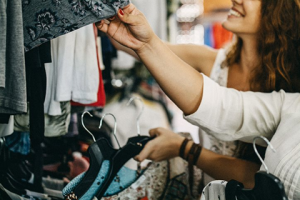Wear, Care and Repair Swishing Toolkit

Every year an estimated 336,000 tonnes of used clothing gets thrown away in the UK, ending up in landfill or going to energy from waste. If clothes stayed in active use for longer it would help to reduce the impact on the environment. For further information about the environmental impact of clothing read Wear, Care and Repair.
One effective way of keeping clothes in use for longer, even if they are no longer wanted, is to swap them with other people. We use the term ‘Swishing’ for clothes swapping events and they’re a great way of reducing clothing waste and a fun way to save money. You swap items you no longer wear for something else that you like or need.
We’ve put together some guidance below to help you run your own swishing events:
Contents
- Planning your event
- Promoting your event
- On the day

Pick a venue
Firstly, you’ll need to decide where you’re going to hold the event. This could be a table in the office to swap amongst colleagues, your front room with a group of friends, or your local village hall or community centre if you’re wanting to hold a bigger event.
For larger events, you will need to consider:
- Is the venue accessible for everyone, including pushchairs and wheelchair users?
- Is there adequate parking?
- Are there appropriate facilities?
- Will the venue be big enough to accommodate the number of expected visitors?
- If this event is open to everyone, does the venue have public liability insurance?
Risk Assessment

Risk Assessment
It’s also important to consider any risks involved with events. This will allow you to avoid any unnecessary risks but also evaluate and control any acceptable risks that remain, to prevent an accident occurring. Completing a Risk Assessment in advance will help you plan the event, promote a positive safety culture and ensure that you comply with legal obligations and reduce risks of claims against you.
We’ve included an example of a Risk Assessment below, which covers a variety of relevant points to consider. Please take a look before completing your own Risk Assessment.
Risk Assessment Template example (Word)
Choose a date
When picking the perfect date for you event, it’s important to give sufficient notice to save the date and this gives people enough time to sort out which items they might like to bring to the swap.
You might also want to consider setting up a drop off point for items to be left before the event starts – this could be a longer period of accepting donations in the run up to the event, or a couple of hours before.
Recruiting volunteers
If you’re opening your event up to the public, you’ll probably need a couple of people to lend a hand on the day, so having a few volunteers to help organise, promote and manage the event can be very useful.
Volunteers can help:
- Spread the word by putting up posters around the community or publicising the event on social media
- Welcome people at the door on the day
- Assist those attending the event
- Sign items in and out, if you’d like to keep a record of what’s been given and taken
Top tips
- Make sure your venue is suitable – and you’ve got the right insurance if you need it
- Remember to complete a risk assessment in advance
- Give yourself plenty of time to plan and promote the event
- Consider if you need some extra help or support on the day
- Make a list of all the jobs required so you can see where you might need help

How’s it going to work?
There are a variety of options for running your event, and so you’ll need to decide which will work best for you.
Things to consider:
- Is there an entrance fee to help recover any costs?
- Do people need to bring an item with them to enable them to take an item, or can people attend and take something without bringing anything themselves?
- Do you want people to bring their items on the day or can they be dropped off in advance?
- How are you going to display the clothes? on a rail or laid out on tables?
- Is the event for just clothes or do you want to include accessories, such as shoes/bags and belts etc?
- How will you categorise or group the items? Ideally you want the layout to be immediately clear to attendees
- Will there be somewhere for people to try the clothes on? Having mirrors available is also a good idea
- What will you do with any items that remain? It’s good to decide this in advance and inform potential attendees
- Will you be providing refreshments?
- How will you gauge if the event is successful? Could you ask attendees to provide feedback before they leave?
We’ve listed a few popular swapping systems below and so it’s worth deciding in advance, how you want your swap to work:
- Free-for-all
Attendees can take as many items as they like regardless of how many items they brought with them. - Ticket system
Tickets can be handed out depending on how many items are brought to the swap. Each ticket is then exchanged for a single item. This is a good way to limit the number of items that are taken by each attendee. - Points system
You may feel that a like-for-like swapping system based on item value is fairer than a free-for-all swap. Items can be assigned a ‘points’ value depending on their worth and attendees can only take items summing the total point value of what they brought. - Raising money for charity
Your event could be used as an opportunity to raise money for charity by allowing people to donate money in return for any items they take.
A clear swapping system can be important, especially for larger swaps, or those with an entry fee – although for small swaps with friends a free-for-all can be great fun!

Spreading the word
Don’t be afraid to start small initially by just inviting friends and family. You could ask everyone to bring a friend or two, as the more participants you have, the greater the choice of items will be.
For swishing events that are open to the public, additional advertising may be necessary to let people know that the event is taking place.
There are several ways you can publicise your event for little or no cost:
- Social media is a great, low-cost way of advertising, as posts can be easily shared and reached by many people. Think about creating an event page on Facebook and invite friends and family, or for larger, public swaps, share the event details in your local community Facebook groups.
- Putting up posters in public areas such as libraries, community centres and on village notice boards can be easy publicity and don’t underestimate the power of local word of mouth.
- If you want to reach a wider audience, consider getting in touch with community magazines and newspapers, and ask if they’ll feature the event.
Let people know what to bring
Ask people to bring clean clothes in good condition and include any other instructions, such as whether you want them to bring clothes on the day or in advance, if there is an entrance fee and what the system for swapping is. You will also need to give the timings for the day, location for the event and any parking instructions or travel guidance.
Provide clear guidance in your marketing so that people know what to expect when they arrive and what you expect from them. It’s also worth mentioning what you plan to do with any remaining items after the event.

At the event
Make sure there is clear signage outside of the venue, so people know where to go. You will also need to ensure that there is either someone to tell them how it works at the entrance or clear directions to follow to make sure that the event runs smoothly.
Whether the clothes are laid out on tables or hanging on rails, it will make it easier for attendees to find what they’re looking for if they are categorised. Having full-length mirrors available and perhaps a separate area to try clothes may help ensure that people only take items that fit and are likely to be worn.
Swapping events should be fun, so try your best to create a friendly environment and positive atmosphere to encourage a spirit of goodwill.
Any items remaining at the end of the event can either be donated to a charity or kept for a future event.
Any items not suitable for wearing could be taken to a charity shop and labelled as rags or taken to your nearest recycling and household waste site or textile bank.
As with any event it’s a good idea to sit down afterwards with those involved for a debrief to discuss what worked well and what could be done differently as this can improve future events. You could also consider gathering feedback from attendees on a flip chart, post-it-note or quick survey before they leave so that you know what their experience of the event was like. It could be that in future you decide to widen the remit of the events to include a greater range of items and not just clothing?

Also in Wear, Care and Repair Sub menu










